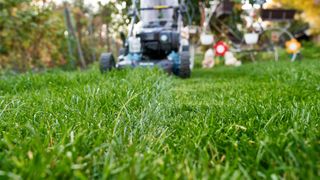Of course, all of this ties into the essential act of mowing your lawn. This is the best way to encourage your grass to grow, especially if you want a thick grass type to flourish. It helps if you have the right tools for the job, so if you are still looking for your ideal garden buddy, read our guides to the best gas lawn mowers and the more eco-friendly electric lawn mowers (opens in new tab). Within this guide, we’ve included advice on how to cut your lawn to the best height in both the summer and winter months, as maintaining a healthy garden is a year-round task. There’s no absolute universal rule for lawn heights since conditions and climates are so changeable across the US; rather, our approach is based on accommodating both warmer and colder weather patterns. If you want to perfect your lawn height, but are currently faced with a less than satisfactory tool, it might be worth investing in a new model so you can make a fresh start. There are plenty of deals to upgrade your backyard with, thanks to all the cheap lawn mower deals (opens in new tab) you can jump on, and most have features that can make your life easier instantly, including easily removable clipping bags and wider cutting paths. As well as allowing unsightly weeds to prosper, neglecting how to cut your lawn to the best height can create a haven for all sorts of garden pests, like slugs, so it’s best to tackle the issue while summer is still here. The experts over at Troy-Bilt (opens in new tab) agree, sharing its recommended first steps when it comes to lawn height: “Identifying your plant hardiness zone is the first step in maintaining the ideal mowing height for the health of your lawn, as you can better understand your growing environment and what thrives best in your location.” To get started and check out your plant hardiness zone, head to the USDA website (opens in new tab), where you can find information about your state’s conditions. And, for more tips on how to create an enviable backyard, check out our tips on how to create lawn stripes (opens in new tab).
What length should you cut your grass?
Cool-season grass Troy-Bilt explains that states in the northern region of the US will most likely have cool-season grass. These grasses are much better at dealing with changing temperatures and see the biggest growth in the spring and fall seasons. You should cut your cool-season grass at a height of between 2 and 3 inches. Troy-Bilt explains that for ryegrass, 2 inches is the optimum height. The experts add ‘because of its fast growth and shallow root systems, ryegrass should be mowed often but shouldn’t exceed 2 inches’. For Kentucky Bluegrass, 2.5 inches is an ideal height, and Fescue grass can be cut at 3 inches. Warm-season grass Typically, as the name suggests, you’ll find warm-season grasses in the more southern regions of the US. Warm-season grasses do most of their growing in the summer months and then tend to lie dormant when it’s cooler. Troy-Bilt recommends an average lawn length of 2 inches for warm-season grasses. Examples of this type of grass include Bermuda and Zoysia, which should be cut at 2 inches high, whereas St. Augustine grass, which typically grows near the coast, should only be cut ‘after exceeding 3 inches in height’. As a general rule, whichever type of grass you have, it’s best to avoid cutting it any shorter than 2 inches.
All-round lawn care tips
As well as assessing which lawn cutting technique is best for your garden based on the state you live in, there are some general tips that can help you along with the entire process. The first is to keep up a schedule with your mowing, which is most easily done within the brighter summer months. Good practice will see you mowing your lawn every five to seven days, as well as mowing in different patterns in order to prevent your soil from becoming compacted. Generally, it’s also better to mow on dry days; this is on account of both the soil and the grass, as wet clippings can have a negative impact on your lawn’s health by smothering the layers below. And of course, you should be wary in scorching summer months of over-mowing, in case of drought, so your lawn builds up resistance and doesn’t brown in the hot sun. If you have a large plot of land to mow and want to get a real grip on the correct cutting heights for an all-over pristine look, then consider opting for one of the best rider lawn mowers (opens in new tab), which have intuitive controls to allow you to make changes from the driving seat.
What to do what your lawn clippings
Once you’ve perfected your lawn’s height, you might be wondering if there’s anything practical you can do with your excess clippings. Composting is the perfect solution for any keen gardener to promote grass growth. Simply add your clippings to a compost bin and mix them with a carbon-rich material and wait for them to aerate. Then you can apply the compost to your lawn in hotter months in order to keep the moisture all locked in.
